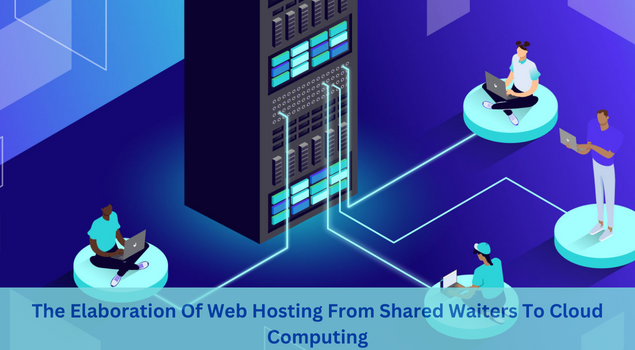The Elaboration Of Web Hosting From Shared Waiters To Cloud Computing In the ultramodern digital geography, web hosting daises as the foundational pillar upon which the entire internet is erected. From the early days of static HTML runners to the dynamic, data-driven websites and operations of the moment, the elaboration of web hosting has been nothing short of revolutionary. In this comprehensive composition, we claw into the trip of web hosting, exploring its colorful forms, technologies, and the profound impact it has had on the way we interact with the online world.
Introduction to Web Hosting

At its core, web hosting refers to the service that enables individuals and associations to make their websites accessible via the World Wide Web. Every website you visit, every online store you read, and every social media platform you engage with is hosted on a garçon — an important computer that stores and serves website lines to druggies across the globe.
The Early Days Shared Hosting and Static Websites
In the incipient stages of the internet, web hosting was a far cry from the sophisticated structure we see now. Websites were generally stationary, conforming to simple HTML runners devoid of dynamic content or interactive rudiments. Shared hosting surfaced as the dominant form of web hosting during this period, wherein multiple websites were hosted on a single garçon, participating in its coffers and structure.
The Rise of Dynamic Content and Devoted Waiters
As the internet evolved, so did the demands placed on web hosting services. The emergence of dynamic content — powered by garçon- side scripting languages similar to PHP, ASP, and Ruby on Rails — steered a new period of interactivity and functionality. devoted waiters gained fashionability, offering enhanced performance and trustability by earmarking an entire garçon to a single website or customer.
Virtual Private Waiters ( VPS) and the Quest for Scalability
The need for scalability and resource allocation gave rise to Virtual Private waiters( VPS), a virtualized hosting terrain that partitions a single physical garçon into multiple virtual waiters. VPS hosting offers lesser control and inflexibility than participated hosting while maintaining cost- effectiveness — a pivotal factor for growing businesses and enterprises.
Enter the Cloud Revolutionizing Web Hosting

The arrival of pall computing marked a paradigm shift in the field of web hosting. pall hosting leverages the power of virtualization, distributed computing, and on-demand resource allocation to deliver unequaled scalability, trustability, and performance. Unlike traditional hosting models, which calculate on physical waiters, pall hosting operates across a vast network of connected waiters and data centers.
Types of Cloud Hosting Services
Cloud hosting services come in colorful forms, each immolation with unique features and capabilities acclimatized to different use cases and conditions. Understanding the different types of pall hosting services is pivotal for businesses seeking to work the benefits of pall computing effectively. Below are the primary types of pall hosting services

Structure as a Service( IaaS)
Structure as a Service( IaaS) is a foundational subcaste of pall computing that provides virtualized computing coffers over the internet. With IaaS, businesses can pierce and manage abecedarian structure factors, including virtual machines( VMs), storehouses, networking, and operating systems, without the need to invest in physical tackle.
IaaS offers unequaled inflexibility, allowing businesses to emplace and gauge structure coffers on- demand, grounded on their specific conditions. Examples of IaaS providers include Amazon Web Services( AWS), Microsoft Azure, and Google Cloud Platform( GCP).
Platform as a Service( PaaS)
Platform as a Service( PaaS) is a pall calculating model that offers a complete development and deployment terrain for structure, testing, and planting operations. PaaS providers offer a range of development tools, middleware, and runtime surroundings, allowing inventors to concentrate on rendering and operation sense without the burden of managing underpinning structure.
PaaS services generally include operation hosting, database operation, interpretation control, and bus-scaling capabilities, streamlining the operation development lifecycle. Popular PaaS platforms include Heroku, Microsoft Azure App Service, and Google App Engine.
Software as a Service( SaaS)
Software as a Service( SaaS) delivers software operations over the internet on a subscription base, barring the need for druggies to install, maintain, and update software locally. SaaS operations are hosted and managed by third-party providers, who handle structure conservation, security, and upgrades, allowing druggies to pierce operations via web cybersurfers or APIs.
SaaS immolations gauge a wide range of orders, including productivity tools, collaboration software, client relationship operation( CRM) systems, and enterprise resource planning( ERP) results. examples of popular SaaS operations include Salesforce, Microsoft Office 365, and Google Workspace( formerly G Suite).
Function as a Service( FaaS)/ Serverless Computing

Function as a Service( FaaS), also known as serverless computing, is a pall calculating model that enables inventors to emplace individual functions or pieces of law in response to specific events or triggers. With FaaS, inventors can write laws to perform specific tasks or execute business sense without provisioning or managing waiters.
The Cloud provider automatically allocates and scales coffers grounded on demand, charging only for the cipher time consumed by the function prosecution. FaaS is ideal for event-driven and microservices infrastructures, offering scalability, cost-effectiveness, and rapid-fire development cycles. Popular FaaS platforms include AWS Lambda, Azure Functions, and Google Cloud Functions.
Container as a Service( CaaS)
Container as a Service( CaaS) is a pall calculating model that provides a platform for planting, managing, and orchestrating containerized operations.
CaaS objectification down the underpinning structure and operating system, allowing inventors to concentrate on the structure and running containerized operations using tools similar to Docker and Kubernetes. CaaS platforms offer features similar to vessel unity, bus scaling, service discovery, and operation lifecycle operation, enabling businesses to emplace and manage containerized workloads with ease.
Examples of CaaS immolations include Amazon Elastic Kubernetes Service( EKS), Azure Kubernetes Service( AKS), and Google Kubernetes Engine( GKE).
Database as a Service( DBaaS)
Database as a Service( DBaaS) is a pall calculating model that provides managed database services to druggies, barring the need for businesses to install, configure, and maintain database software and structure.
DBaaS providers offer a range of database machines and configurations, including relational databases(e.g., MySQL, PostgreSQL, SQL Garçon) and NoSQL databases(e.g., MongoDB, Cassandra, DynamoDB). DBaaS immolations generally include automated backups, scaling, monitoring, and security features, allowing businesses to concentrate on data operation and operation development. Examples of DBaaS providers include Amazon RDS, Azure Database, and Google Cloud SQL.
Benefits of Cloud Hosting
Scalability
Cloud hosting allows businesses to gauge coffers up or down in real-time, icing optimal performance and cost-effectiveness.
Trustability
By distributing coffers across multiple waiters and data centers, pall hosting minimizes the threat of time-out and ensures high vacuity.
Flexibility
Cloud hosting offers unequaled inflexibility, allowing druggies to customize and configure their hosting terrain to meet specific conditions.
Cost-effectiveness
With pay-as-you-go pricing models and no outspoken tackle costs, pall hosting is a cost-effective result for businesses of all sizes.
Challenges and Considerations
While all hosting offers multitudinous benefits, it also presents its own set of challenges and considerations

Security
As data is stored and transmitted over the internet, security enterprises similar to data breaches and cyber-attacks must be addressed through robust security measures and encryption protocols.
Compliance
Depending on the assiduity and geographic position, businesses may be subject to colorful nonsupervisory conditions and compliance norms governing data sequestration and security.
Vendor Lock-In
Migrating between Cloud providers can be complex and expensive, leading to seller cinch-heft and limited inflexibility in the long term.
The Future of Web Hosting
Looking ahead, the future of web hosting pledges indeed lesser invention and advancement. Arising technologies similar to edge computing, serverless armature, and containerization are reshaping the hosting geography, offering new openings for effectiveness, performance, and scalability.
Conclusion
From the humble onsets of participated hosting to the measureless eventuality of pall computing, the elaboration of web hosting glasses, the rapid-fire pace of technological progress in the digital age. As businesses and individuals continue to harness the power of the internet to connect, unite, and introduce, web hosting will remain a critical enabler of the online experience, driving the coming surge of digital metamorphosis and growth.
In summary, the trip of web hosting — from participated waiters to pall computing — stands as a testament to the imagination and rigidity of mortal invention, shaping the way we interact with the online world for generations to come.




